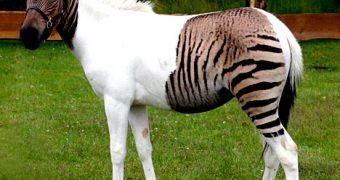No, this is not about insufficient white paint. Because this is not an incompletely painted zebra. There is no artificial coloring on the animal you see. This a female zorse: her father is a zebra, while her mother is a mare, this being the classical example of how a child receives a mix of genes from both progenitors.
What is more unusual in this case is that while most zebra-horse crossbreeds "wear" stripes, even if across their entire body, this specimen displays just two such patches, on its face and rear.
Baptized Eclyse, one-year-old zorse is an accident, after her mother, Eclipse, spent a short period of time, while traveling from her German safari home park to an Italian ranch, where other horses and a number of zebras, including a male named Ulysses, were roaming freely. Eclipse's keepers were taken by surprise by the result of the pregnancy, whose mixed markings left no doubt about who the father was.
The foal has turned into a major attraction at a safari park at Schloss Holte Stukenbrock, near the German border with Holland, where it even has its own yard. "You can tell she is a mix just by looking at her. But in temperament she can also exhibit characteristics from each parent. She is usually relatively tame like a horse but occasionally shows the fiery temperament of a zebra, leaping around like one." said Udo Richter, spokesman for the park.
Horses and zebras are often crossbred in Africa and the hybrids are employed as trekking animals on Mount Kenya.
Horses, donkeys, onagers (Asian wild donkeys) and zebras are closely related, belonging to the same genus, Equus, even in distinct evolutionary lineages. Horses and donkeys are crossbred for a long time: the mule is the result of a cross between a donkey and a mare, while the hybrid between a stallion and a jenny (female donkey) is called hinny. Still, donkeys and zebras are more related with each other than they are with the horses.

 14 DAY TRIAL //
14 DAY TRIAL //